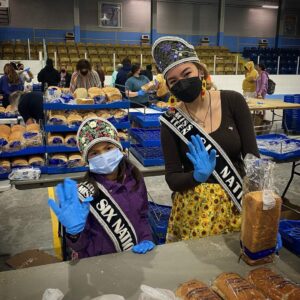LAMBETH, ON – Over 300 delegates from Quebec, Ontario, New York State, and Wisconsin attended the recital of the Rotinohsionni master narrative called the Kayanerensherakowa or the Great Law of Peace at Oneida of the Thames from August 14 to 18 near London, Ontario.
The Great Law describes the foundations of the Wisk Nihohnohnwhentsyake or what has been called the League of the Five Nations—the model used for the international League of Nations.
The recital of the Laws was conducted in Onkwehonweneha by Bob Brown, an Oneida, assisted by Mohawk elder Tom Porter, who translated the narration into English. Other speakers included Leroy Hill from Ohsweken, and Richard Mitchell from Akhwesahsne. The recital began with a tobacco burning ceremony on Tuesday, August 13 that was followed by a workshop and discussion on decolonizing Onkwehonwe Indigenous knowledge and governance.
The actual recital began on August 14 with sessions that lasted from 9 am until 1 pm daily. The final session on Sunday August 18 lasted until 4 pm.
The first three days of the Great Law recital focused on the master narrative, the retelling of the formation of the League, the role of Tekanawite and his encounters with a variety of figures in league history such as the Tsi Konsase, the Handsome Cannibal, the sorcerer Atotarho, and the Mohawk warlords Ayonwatha, Tekarihoken, and Tsatekariwate. Also described was how the Oneidas, Cayugas, and Senecas joined the League.
The League was formed by 12 founding member families: the three Mohawk turtle families Ayonwatha, Tekarihoken, and Tsatekariwate; three Oneida wolf families Rotatshete, Kanakweyoten, and Teyonhakwen’n; three Cayuga families Teyonhtharekwen, Teyonh’hyoronkwen, and Wennenhs; the Onondaga family of Atotarho; the two Seneca families of Skanyatariyo and Satekaronyes.
The Small Condolence (Wiping of the Tears) conducted on Friday was an important part of the Great Law recitals attended by many of the old League families – by tradition Great Law families holding titles may renew their duties because that is when all the laws are read.
The final two days focused on protocols followed by the chiefs in their duties with some attention paid to the conducting of the Grand Council. A short presentation also described the Large Condolence ceremony when candidates are presented to the League from each of the Wisk Nihohnohnwhentsyake Indigenous peoples.
The chiefs’ roles was the major focus for this Great Law, with only short attention paid to the central role of the Mothers, and the power of the Peoples’ fires. Presenters noted that they were doing the best they could in the short time they had for the recital.
Historically, the Great Law recital is held over seven to nine days. Two days feature the retelling of the Creation narrative, the arrival of the dark times ruled by warlord-sorcerer
chiefs, and Tekanawite’s mission.
This narrative is followed by a description of the roles, duties, and responsibilities of the chiefs and councils over the next two days. The roles of the Mothers, and the various roles of individuals tending to the day-to-day affairs of the People, are described for another two days.
The final days are spent describing the rights and freedoms of the People, and how they could protect themselves from threats to their peace.
The last session reviews the week and outlined Rotinohsionni development through Kanonwheratonhshera, Kayanerensherakowa, Kariwiyo, and lastly the revitalization of onkwehonweneha during the last days called Kakaratsikowa.
Another recital has been tentatively schedule for Syracuse, NY in 2014.






Comments are closed.